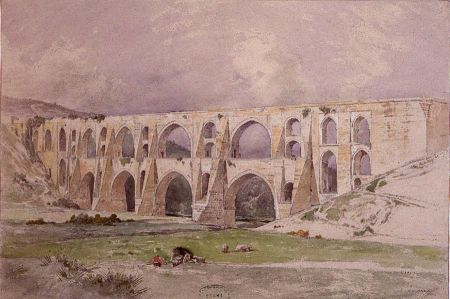Master Builder Sinan - a humble genius
- Written by Portal Editor
On our travels through the historically significant sites of Turkey, we frequently encountered the name of the great master builder and architect of the Ottoman era, Koca Mimar Sinan, the "venerable Master Builder Sinan."
Whether mosque, aqueduct, hammam, or mausoleum, Master Builder Sinan's buildings can be found in many places.
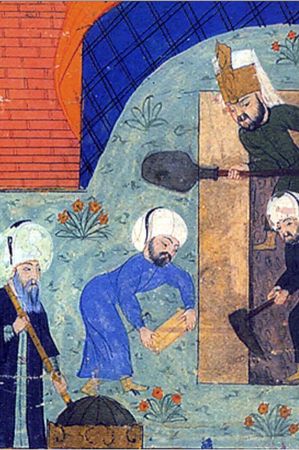 Information about his birthplace should sometimes be treated with caution; all we know for sure is that it was in a central Anatolian village near Kayseri around 1489. His parents were probably Christians, because Sinan only converted to Islam later during his military service. It was customary at the time for the children of Christians, in particular, to be drafted into military service. After his time as a recruit and training in the Sultan's army, he joined the Janissaries and worked as a military engineer. During the Janissary campaigns, which Sinan led throughout the Ottoman Empire, he diligently studied all the building techniques, from the pyramids at Giza to the Roman aqueducts at Side and Aspendos. He was interested in the construction of mosques in their various designs, as well as in the functions of a hammam (the picture presumably shows supervision during construction).
Information about his birthplace should sometimes be treated with caution; all we know for sure is that it was in a central Anatolian village near Kayseri around 1489. His parents were probably Christians, because Sinan only converted to Islam later during his military service. It was customary at the time for the children of Christians, in particular, to be drafted into military service. After his time as a recruit and training in the Sultan's army, he joined the Janissaries and worked as a military engineer. During the Janissary campaigns, which Sinan led throughout the Ottoman Empire, he diligently studied all the building techniques, from the pyramids at Giza to the Roman aqueducts at Side and Aspendos. He was interested in the construction of mosques in their various designs, as well as in the functions of a hammam (the picture presumably shows supervision during construction).
During a campaign against the Persians, Sinan was tasked with building ships to transport troops across Lake Van, which brought him to the attention of Sultan Suleiman I. Thus, despite his advanced age of over 50, Master Builder Sinan was appointed personal and court architect to Sultan Suleiman I. And thanks to the Sultan's enthusiastic support, Sinan was able to quickly implement his plans for mosques, aqueducts, and hammams. In the few years leading up to his death at the age of 97, he ultimately completed more than 470 buildings with incredible diligence and constantly evolving ideas. In Istanbul alone, 42 mosques were built according to Sinan's plans. All the splendor with which Sultan Süleyman I surrounded himself was only made possible by Sinan, the master builder.
Until his death, the greatest architect of the Ottoman Empire remained a humble, devout man who did not abandon this humility even in death. He is buried in a modest türbe of his own design in the Süleymaniye district of Istanbul.
Istanbul and Sinan, the Master Builder
 The skyline of the city of Istanbul is largely determined by two buildings. Barely one and a half kilometers as the crow flies and separated by about a thousand years, stand the Hagia Sophia, the church of the Byzantine Emperor Justinian, consecrated in 537, and the Suleymaniye Mosque, the mosque of the Ottoman ruler Suleiman, completed in 1557.
The skyline of the city of Istanbul is largely determined by two buildings. Barely one and a half kilometers as the crow flies and separated by about a thousand years, stand the Hagia Sophia, the church of the Byzantine Emperor Justinian, consecrated in 537, and the Suleymaniye Mosque, the mosque of the Ottoman ruler Suleiman, completed in 1557.
This view not only reveals an unmistakable parallel, it demonstrates a continuity!
Indeed, the parallels between Suleiman and Justinian are particularly striking. Both ruled an empire at its peak, a vast empire whose borders, incidentally, almost coincided. When Suleiman ascended the Ottoman throne in 1520 at the age of 26, he, like his predecessors, adopted Byzantine customs and protocol. Both Justinian and Suleiman spent money lavishly in the interests of state, and both could afford it. Although he was the symbol of the Muslim threat par excellence for Habsburg Europe – having already stood before Vienna and attempted to seize control of the Mediterranean by conquering Malta, both of which, incidentally, he failed – it is not without reason that Suleiman is known in the West as the "Magnificent." In Turkey, he is called the "Lawgiver," also a parallel to Justinian and his collection of laws, the Codex Justinianus. A very telling epithet, as it reflects the importance given to the codification and enforcement of law and order, internal peace, and prosperity under his rule.
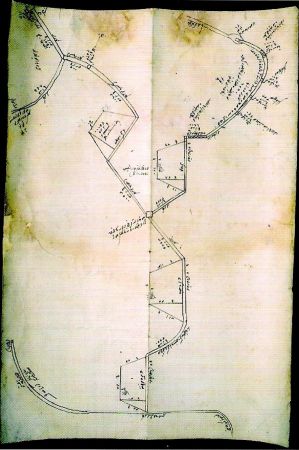 For the population, this program was most clearly expressed in the buildings constructed during his long 46-year reign. Mosques and schools, roads, bridges and caravanserais, baths, aqueducts, and fountains were built. This not only promoted trade and caused the economy to boom, but also testified to efficient administration and provided for the intellectual and spiritual needs of the people.
For the population, this program was most clearly expressed in the buildings constructed during his long 46-year reign. Mosques and schools, roads, bridges and caravanserais, baths, aqueducts, and fountains were built. This not only promoted trade and caused the economy to boom, but also testified to efficient administration and provided for the intellectual and spiritual needs of the people.
So here we have a ruler who possessed power and wealth and wanted to invest both generously in architectural projects and charitable foundations, in the promotion of art and culture, and in all signs of imperial splendour. And just as under Justinian, Anthemius of Tralles and Isidorus of Miletus arched the dome over the vast interior of the Hagia Sophia with unprecedented boldness, so too under Suleiman, a brilliant architect, Master Builder Sinan, appeared.
As a young man, he was a soldier, an engineer in the Sultan's Janissary corps, and built military installations. At that time, his supreme commander was Selim the Strict, who spent practically his entire life at war and continuously expanded the Ottoman Empire. Thus, the first fifty years of Sinan's life passed.
... and his architect Master Builder Sinan
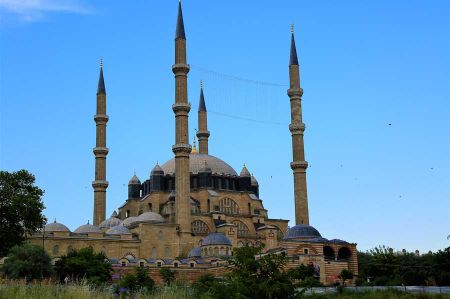 At an age when many people's drive already significantly diminishes, Sinan began his true career under Selim's son Süleyman. After a few interim steps, he was appointed chief architect of the empire. A genius rarely found among architects, blessed with a seemingly inexhaustible creative power, he had at his disposal the equally inexhaustible resources of a world empire at its peak and the uninterrupted support of its ruler.
At an age when many people's drive already significantly diminishes, Sinan began his true career under Selim's son Süleyman. After a few interim steps, he was appointed chief architect of the empire. A genius rarely found among architects, blessed with a seemingly inexhaustible creative power, he had at his disposal the equally inexhaustible resources of a world empire at its peak and the uninterrupted support of its ruler.
Scholars debate the exact significance of the Hagia Sophia, already the Aya Sofia Mosque at that time, for Sinan's architectural art. The fact is that this massive, beautiful structure has stood conspicuously for a thousand years, that Sinan devoted himself extensively to it, if only because he was entrusted with consolidation tasks and built two of the four minarets, and that the mosque commissioned by Suleiman, the Süleymanye, is very similar to it.
The result, however, is not an imitation copy, but rather an adaptation to the new times and the requirements typical of a mosque—precisely what one understands as a renaissance.
Parallels between the Hagia Sophia and the Süleymanye Mosque
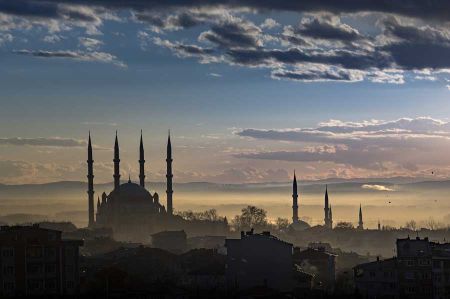 The Süleymanye, with its surrounding foundation complex of schools, madrasas (theological colleges), hospital, soup kitchen, hospital, hammam, and caravanserai, was arguably the most important educational and charitable institution in the Western Hemisphere, but certainly the pinnacle of Ottoman architecture in Istanbul. And yet, Sinan still managed to surpass himself.
The Süleymanye, with its surrounding foundation complex of schools, madrasas (theological colleges), hospital, soup kitchen, hospital, hammam, and caravanserai, was arguably the most important educational and charitable institution in the Western Hemisphere, but certainly the pinnacle of Ottoman architecture in Istanbul. And yet, Sinan still managed to surpass himself.
In Edirne, a city near the Bulgarian-Greek border, he built his absolute masterpiece, the Selimiye Mosque, for Suleiman's successor, Selim II. With its enormous dome, almost as large as that of the Hagia Sophia, and its four pencil-thin, seventy-meter-high minarets, it still dominates the city today. It was completed in 1575, when Sinan was 85 years old.
And Master Builder Sinan still didn't retire. He made pilgrimages to Mecca, a great effort even for younger men, and built, built, built until his last hour.
It is said that he died as a result of an industrial accident. That would be fitting for him.
Sinan's Buildings as "World Heritage Sites"
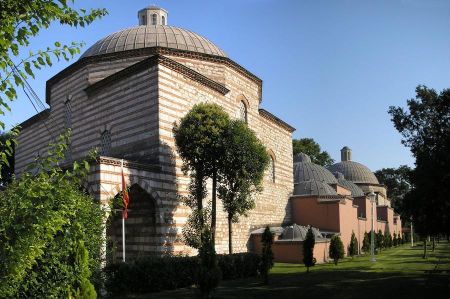 If Sinan had created nothing other than the great imperial Friday mosques, his fame would have been assured. As it is, his work encompasses over 400 major building projects throughout the Ottoman Empire, and the Freely/Sumner-Boyd Istanbul guide still lists 120 buildings that have survived in Istanbul alone!
If Sinan had created nothing other than the great imperial Friday mosques, his fame would have been assured. As it is, his work encompasses over 400 major building projects throughout the Ottoman Empire, and the Freely/Sumner-Boyd Istanbul guide still lists 120 buildings that have survived in Istanbul alone!
Indeed, there is no other architect who could rival Sinan in terms of the sheer volume of his work.
Fortunately, he repeatedly found generous clients who made the realization of this never-ending stream of creative ideas possible.
Incidentally, there are virtually no maps that show the Balkans and Anatolia on the same page. Centuries-old prejudices have led cartographers to unconsciously always make a cross-section through the Aegean Sea (see Kitsikis).
This cross-section also runs through our minds.
Isn't it time to recognize Master Builder Sinan's brilliant work as a heritage of humanity and finally bring him into the consciousness of the Western world?
Author: Sabina Jarosch
Please also read:
The Selimiye Mosque in Edirne - Mimar Sinan
Amsterdam and the De Wallen district – attractive but unique
